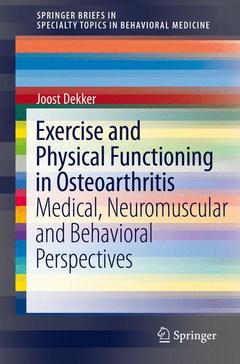Exercise and Physical Functioning in Osteoarthritis, 2014 Medical, Neuromuscular and Behavioral Perspectives SpringerBriefs in Specialty Topics in Behavioral Medicine Series
Coordonnateur : Dekker Joost

Osteoarthritis (OA) is among the top 10 of most disabling diseases in the Western world. It is the major cause of pain and disability among the elderly. This book provides a contextual review of recent research on neuromuscular factors and behavioral risk factors for functional decline in OA, with a special emphasis on explanatory mechanisms. In addition, the book discusses innovative approaches to exercise and physical activity in OA, derived from research on behavioral and neuromuscular risk factors for functional decline in OA. Recent research has shown that neuromuscular factors (such as muscle strength, joint laxity) and behavioral factors (such as avoidance of activity, depressed mood) predict pain and disability in OA. Furthermore, exercise and physical activity are among the dominant interventions aiming at reducing pain and disability, and innovative interventions targeting neuromuscular and behavioral interventions have been recently developed. This research has been published as separate papers, with the result that the field is in need of an integrative contextual review that puts the research into theoretical perspective.
TARGETED MARKET SEGMENTS
Rehabilitation specialists, health psychologists, gerontologists, rheumatologists, pain specialists
Reviews recent research on neuromuscular factors and behavioral risk factors for functional decline in OA
Gives special emphasis to explanatory mechanisms
Discusses innovative approaches to exercise and physical activity in OA
Date de parution : 09-2013
Ouvrage de 132 p.
15.5x23.5 cm
Thèmes d’Exercise and Physical Functioning in Osteoarthritis :
Mots-clés :
Arthritic pain research; Behavioral treatment for pain; Exercise and health; Exercise therapy; Hip pain research; Knee pain research; Neuromuscular pain research; OA; Obesity and osteoarthritis; Osteoarthritis; Overweight and osteoarthritis; Pain rehabilitation; Physical activity and health; Risk factors for arthritis



